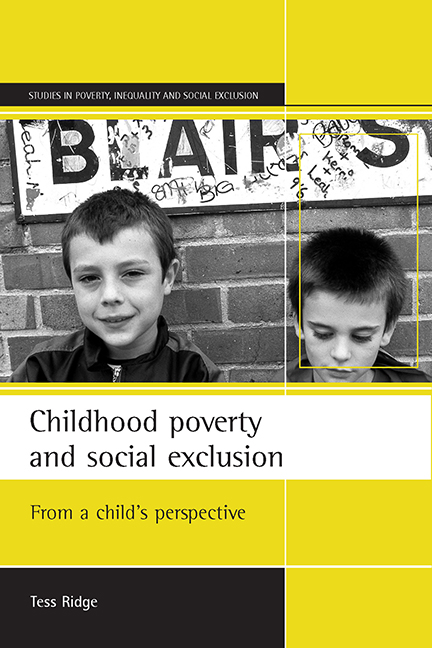Book contents
- Frontmatter
- Contents
- List of tables and figures
- Acknowledgements
- one The challenge of child poverty: developing a child-centred approach
- two What do we know about childhood poverty?
- three Children’s access to economic and material resources
- four ‘Fitting in’ and ‘joining in’: social relations and social integration
- five Family life and self-reflection
- six Experiences and perceptions of school: analysis of the BHPYS data
- seven Childhood poverty and social exclusion: incorporating children’s perspectives
- References
- Appendix BHPYS Wave 7
- Index
three - Children’s access to economic and material resources
Published online by Cambridge University Press: 20 January 2022
- Frontmatter
- Contents
- List of tables and figures
- Acknowledgements
- one The challenge of child poverty: developing a child-centred approach
- two What do we know about childhood poverty?
- three Children’s access to economic and material resources
- four ‘Fitting in’ and ‘joining in’: social relations and social integration
- five Family life and self-reflection
- six Experiences and perceptions of school: analysis of the BHPYS data
- seven Childhood poverty and social exclusion: incorporating children’s perspectives
- References
- Appendix BHPYS Wave 7
- Index
Summary
The following three chapters present the empirical findings from in-depth interviews with 40 children and young people living in poverty. They cover three main areas in children's lives; this chapter explores the financial and material aspects of children's lives; Chapter Four looks at the social and relational aspects, focusing in particular on children's lives at school; and Chapter Five focuses on the children's home environment and their personal and familial lives. The paramount aim of the qualitative study was to use children's own subjective accounts to develop a child-centred understanding of childhood poverty and social exclusion; as a consequence, wherever possible children's own voices have been used to illustrate their accounts.
Material resources and capabilities
In this chapter, we focus on children's accounts of their opportunities to access economic and material resources, and explore some of the socioeconomic issues that children raise. Childhood, like adulthood, is deeply steeped in the consumer culture of our time. A higher standard of living leads to increasing demands and escalating pressures on families struggling to achieve adequate social integration and social standing. Childhood has its own social and cultural demands, and children's need for financial resources and their desire to attain certain commodities reflects not just the ‘common culture of acquisition’ (Middleton et al, 1994) but also the significance of consumer goods as a means of communication between young people (Willis et al, 1990). The children in this sample were living in families where they were likely to be experiencing poverty over a long duration. Thus, the issue of children's capacity to access adequate financial and material resources to ensure social participation was one that clearly had profound implications for them.
To explore the importance of economic resources in these children's lives, this chapter focuses on three key areas:
• Children's and young people's access to pocket money as a secure financial resource. Pocket money or an allowance is the main medium through which children and young people generally gain access to their own source of money. This first section explores whether children in low-income families were able to access their own reliable source of pocket money, and what role pocket money played in their lives.
- Type
- Chapter
- Information
- Childhood Poverty and Social ExclusionFrom a Child's Perspective, pp. 37 - 58Publisher: Bristol University PressPrint publication year: 2002



